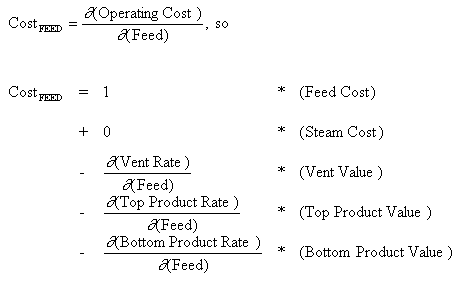目标函数
根据一系列MV和CV的操作约束,稳态线性规划计算出一个新的稳态工作点,使得系统最大限度地减少目标函数值。
目标函数由两项组成:经济项和CV稳态误差惩罚项。
其中M是一个大的正数。
第二项的高权重保证了稳态优化将首先消除CV稳态超限,其次才是最大限度降低运行成本。
运营成本
注意:
需要着重理解的是,此处所指的运行成本是DMCplus控制器范围内控制单元部分的运行成本。稳态成本是偏导数。
某个MV的稳态成本是指当该变量变化,同时保证其它所有MV恒定时的运行成本变化值。计算稳态成本的工作涉及到想出运行成本计算并且扰动或差异化该计算,以产生MV的稳态成本。
简单来说,运行费用计算方法如下:
大多数涉及计算稳态成本的工作都是与运行成本计算相关联的。公用工程消耗和产品流量(有时候进料流量也需要)必须表示为MV的函数。说明稳态成本如何计算的最好方法是通过下面一个例子。
图34:一个简单精馏塔
图34所示简单精馏塔有四个操作变量。运营成本被定义为:
放空速率、塔顶产品流率和塔釜产品流率是MV的函数。
因此,运行费用可用MV表示成:
进料稳态成本可按下述计算:
这个公式的偏导数项无非是相对于进料量变化的产品流率稳态增益(保持其它MV恒定)。同样地,在获取相对于其它MV的产品流率稳态增益之前,必须保证这些变量的成本可以被计算。
为了计算稳态成本,必须获得这些稳态增益。有两种方法可以做到。如果该精馏塔的离线模型可用,则可以通过施加扰动获得增益。模型应该初始化到正常工作区域。要对4个MV进行逐个扰动。除了扰动幅度导致的三个产品流率变化将产生各自产品流率对应该操作变量的稳态误差。
如果没有可用的离线模型,则可以通过DMCplus Model创建一个产品流率对应MV的模型来获得稳态增益。稳态增益可从模型曲线中获得。当然,需要在工厂测试时收集所有三个产品流率测量数据。这也解释了为什么需要将稳态成本计算方法提供给工厂测试。
附原文:
Objective function
The Steady-State Linear Program calculates a new steady-state operating point that minimizes the value of the objective function, subject to a set of operating constraints on manipulated and controlled variables.
The objective function has two terms: an economic term and a CV steady-state error penalty term.
where M is a large, positive number.
The heavy weighting of the second term ensures that the steady-state optimization will first eliminate CV steady-state limit violation before minimizing operating cost.
Operating costs
Note that:
It is important to understand that the operating cost referred to here is the operating cost of the part of the unit within the scope of the DMCplus controller. The steady-state costs are partial derivatives.
For a manipulated variable the steady-state cost is the change in the operating cost for a change in that variable, while holding all other manipulated variables constant. The job of calculating the steady-state costs involves coming up with an operating cost calculation and perturbing or differentiating that calculation, to generate the steady-state costs for the manipulated variables.
In simple terms, the operating cost calculation is as follows:
Most of the work involved in calculating the steady-state costs is associated with the operating cost calculation.The utilities consumption and product flows (and sometime feed flows) must be expressed as functions of the manipulated variables. The best way to illustrate how steady-state costs are calculated is by using an example.
The simple fractionator illustrated in Figure 34 has four manipulated variables. The operating cost is defined as:
The Vent Rate, Top Product Rate, and Bottoms Product Rate are functions of the manipulated variables.
So, the operating cost in terms of the manipulated variables is:
The steady-state cost for the feed is then calculated as follows:
The partial derivative terms in this equation are nothing more than the steady-state gains of the product flows, with respect to a change in Feed Rate, holding the other manipulated variables constant. Similarly, the steady-state gains for the product flows with respect to the other manipulated variables must also be obtained before the costs for these variables can be calculated.
In order to calculate the steady-state costs, these steady-state gains must be obtained. There are two ways to do this. If an off-line model of the fractionator is available, this model can be perturbed to generate the gains. The model should be initialized to the normal operating region.Each of the four manipulated variables are then individually perturbed. Dividing the resulting changes in the three product flows by the magnitude of the perturbation will yield the steady-state gain for that product flow against that manipulated variable.
If no off-line model is available, the steady-state gains can be obtained by using DMCplus Model to build a model of the product flows against the manipulated variables.The steady-state gains can then be obtained from these model curves. This, of course, requires that all three product flow measurements are collected during the plant test. This explains why thought must be given to how the steady-state costs will be calculated prior to the plant test.
2015.10.9












